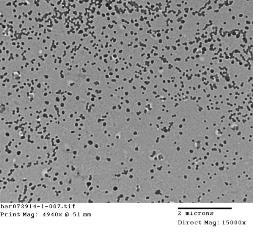Introduction: Release of ophthalmic drugs from nanoparticles should occur at a steady rate over an extended period of time in order to increase the drug residence time and to avoid administering toxic doses[1]. These nanoparticles should degrade over time so that they do not remain within the body. This study was performed to produce a novel nanoparticle formulation for drug delivery in the eye.
Materials and Methods: The nanoparticles were formulated by suspension polymerization of 2-hydroxyethyl methacrylate (HEMA) with ethylene glycol dimethacrylate (EGDMA) or N,N’-bis(acryloyl)cystamine (BAC) as a crosslinker, methacrylic acid for slight charge repulsion between particles, sodium dodecyl sulfate as a stabilizer, and benzoyl peroxide as an initiator. The amounts of the various materials were altered to modify the particle size. Additionally, the type of crosslinker was altered to allow for biodegradability. Average effective particle diameter and polydispersity of the nanoparticle suspensions were determined using dynamic light scattering. Transmission electron microscopy was used to obtain images of the nanoparticles for observation of their morphology and to confirm their size. Drug release profiles were determined by high pressure liquid chromatography with UV detection at 254 nm. Degradability tests were conducted with a 10 mM solution of dl-dithiothreitol (DTT) in phosphate buffered saline mixed with the nanoparticle suspension in a shaking incubator at 37˚C.
Results and Discussion: The range of effective nanoparticle diameters obtained from the formulations which contained EGDMA were 97.83 nm ± 0.46 nm to 125.50 nm ± 0.89 nm. The TEM image of the polyHEMA particles with EGDMA confirms that spherical particles were produced on a nano scale. Loading and subsequent release of drug from the previously mentioned nanoparticles was observed. Nanoparticle formulations made with BAC were found to have effective diameters similar in magnitude to the given range for the EGDMA crosslinked particles. Degradation of the nanoparticle formulations containing BAC were observed in the presence of DTT with varying rates.

Figure 1. Transmission electron microscopy image of PolyHEMA nanoparticles crosslinked with EGDMA.
Conclusion: The results show that novel polymer based nanoparticles that are capable of drug release were produced. Additionally, it is shown that BAC can be used as a crosslinker to modify the initial particle formulation to allow for biodegradability. Further experimentation will be done to continue studies involving the addition of a mucoadhesive component for front of the eye drug delivery and in vitro cell studies.
Natural Sciences and Engineering Research Council of Canada
References:
[1] Sampath Kumar, K., Bhowmik, D., Chiranjib, B., Chandira, M., & Tripathi, K. K. (2010). Innovations in sustained release drug delivery system and its market opportunities. J. Chem. Pharm. Res, 2(1), 349-360.